- Author Matthew Elmers [email protected].
- Public 2023-12-16 21:49.
- Last modified 2025-01-24 09:17.
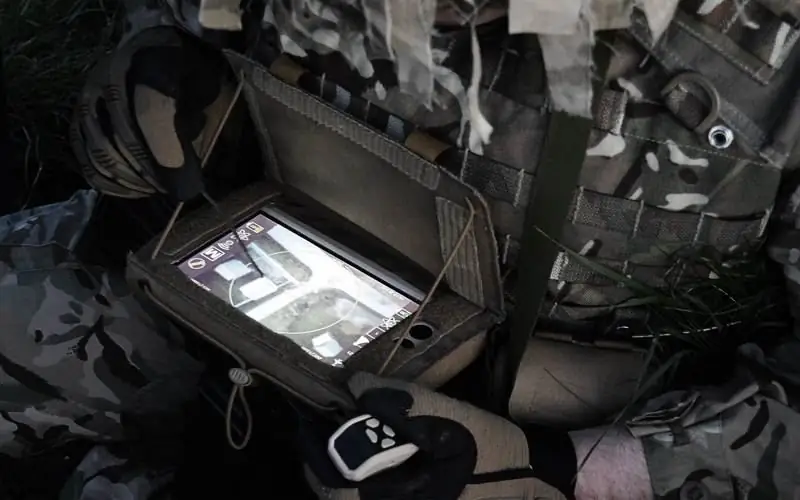
Elbit Systems also demonstrated the capabilities of its SEAGULL 12m Automatic Surface Vehicle (AHA) in a joint exercise with the British Navy. During the exercise, SEAGULL, controlled from the coastal control station, provided rapid detection of "miniform" objects and issued warnings to the British helicopter carrier OCEAN.
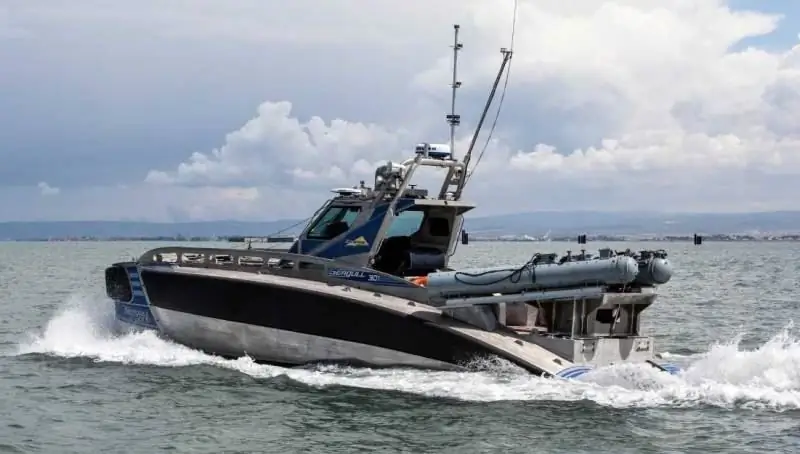
Previously, the capabilities of this AHA in anti-submarine warfare were demonstrated when it deployed a submersible sonar to detect and classify underwater objects, after which it was monitored in real time via satellite channel directly from the company's stand at the DSEI 2017 exhibition in London.
Lockheed Martin and Boeing were awarded $ 43 million in contracts in October 2017 for the development of an Extra Large Unmanned Undersea Vehicle (ORCA XLUUV) for the US Navy. The two companies must vie for the right to manufacture up to 9 of these vehicles, which should perform intelligence and logistics tasks.
Little information is publicly available, but ORCA is expected to descend and return to the home base, navigating to the remote operational area with cargo in a 9.2 m3 compartment. The declared cruising range is 2000 nautical miles. When it arrives at its destination, the device establishes communication with the forces that it provides support, unloads its cargo and returns to base.
Lockheed Martin is also showing interest in other unmanned sailing technology. This is evidenced by the large investment in Ocean Aero, the developer of the SUBMARAN surface craft (photo below), also powered by solar panels, which is capable of diving to a depth of 200 meters in order to avoid the movement of surface vessels and storms or conduct reconnaissance missions.
The investment was preceded by a successful collaboration between the companies in the Demonstration of Unmanned Systems Technology during the Annual Naval Technology Exercise 2016. Lockheed Martin noted that this will demonstrate its expertise in configuring groups of autonomous systems for complex missions.
Thales Australia and Ocuis Technology are also developing a similar system, showing off the coast of Australia in August 2017 their AHA BLUEBOTTLE (photo below) with solar, wind and wave propulsion, which performed anti-submarine missions. The AHA was equipped with a sonar system towed on a 60 meter line; this combination of systems reportedly exceeded all developer expectations in terms of its capabilities.
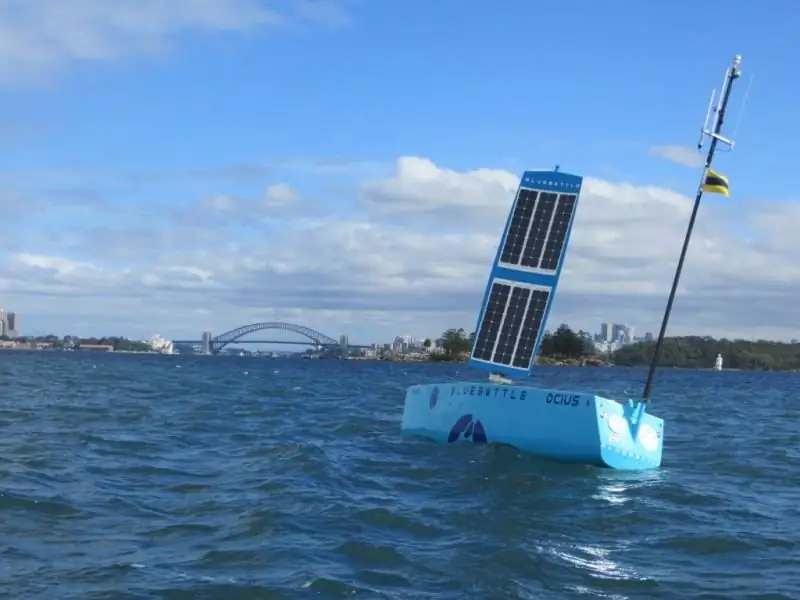
The fleets of many countries have traditionally been reluctant to adopt autonomous systems, but are beginning to realize that the introduction of this technology will increase safety and reliability in a difficult operational environment.
Fleets typically operate a range of underwater or surface vehicles that can remain at sea for extended periods of time and which enable them to identify threats on and under water. However, the fleets consider the air environment to be more problematic for the integration of unmanned systems, especially on board ships.
Australia announced in February 2017 that it had awarded Schiebel a contract for the supply of the CAMCOPTER S-100 drone so that the fleet could assess its needs for this platform as part of the NMP1942 project.
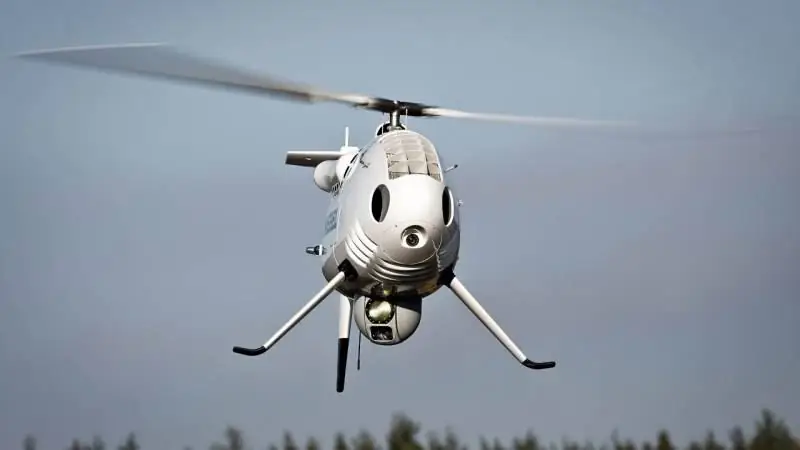
This will be followed by the implementation of the SEA 129 project, which provides for a full-scale purchase of a shipborne drone for Australia, for which, in addition to Schiebel, UMS Skeldar and Northrop Grumman are likely to apply.
In addition, Germany has also been studying the use of this technology for ship operations for some time and in December 2017, UMS Skeldar, together with ESG, announced the completion of joint weekly tests of the R-350 helicopter UAV.
This UAV, equipped with a laser rangefinder and an optoelectronic / infrared camera, during tests performed automatic recognition of the landing site for a manned helicopter out of line of sight.
Leonardo, also very active in unmanned systems, has recently had success with its optionally manned SW-4 SOLO. In February last year, the company announced the first SOLO flight without a pilot. The drone SOLO, based on the Polish light single-engine SW-4 helicopter, took off from an airfield in southern Italy and remained in the air for 45 minutes. According to Leonardo, all systems worked as expected with "excellent control and manageability."
The helicopter underwent a series of tests, including remote engine start, runway run and engine shutdown, automatic takeoff and landing, hovering, forward acceleration, automatic navigation to intermediate coordinates and a simulated reconnaissance mission, while reaching an altitude of 460 meters and a speed of 60 knots. Prior to that, the helicopter had been operating independently for two months, but with a pilot on board, playing an important role in training the Unmanned Warrior at sea.
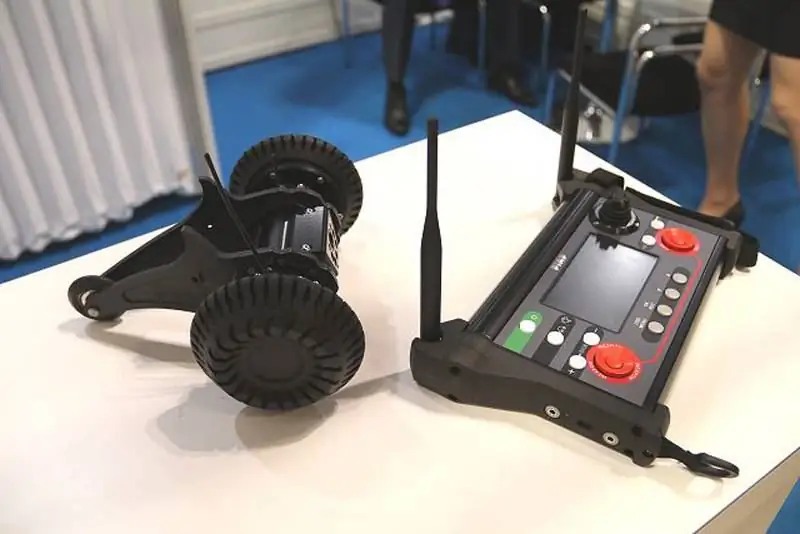
Joint operations
During the three-day Advanced Naval Technology Exercise held in August 2017 at the Naval Surface Weapons Development Center, Northrop Grumman demonstrated various autonomous technologies. The company's advanced development task management and control system has demonstrated the benefits of an open architecture for integrating many capabilities into fleet tasks.
“Conducting underwater attacks using existing technologies and using autonomous platforms for different environments, equipped with network sensors and advanced command and control systems, provides significant offensive and defensive capabilities in the maritime environment,” said a spokesman for Northrop Grumman Aerospace Systems.
During the exercise, several underwater, surface and airborne vehicles were tasked with collecting, analyzing and synthesizing data from various sensors in order to develop real-time solutions that would allow the underwater vehicle to effectively destroy enemy infrastructure on the seabed in the contested space.
DARPA Office CODE Program
The joint action of several devices is also the topic of the DARPA program, called CODE (Collaborative Operation in Denied Environments), "forbidden" in this context means the absence or jamming of the GPS signal. DARPA announced the successful completion of Phase 2 flight tests, which enabled Phase 3 to begin, including upgrading existing aircraft so that they can interact with minimal control.
The goal of the CODE program is to expand the capabilities of existing US military manned aircraft to conduct dynamic captures of highly mobile land and sea targets in contested or forbidden combat spaces.
Many UAVs equipped with CODE technology fly to their operational areas and then search, track, identify and neutralize targets in accordance with the established rules of warfare; the whole group is controlled by one operator.
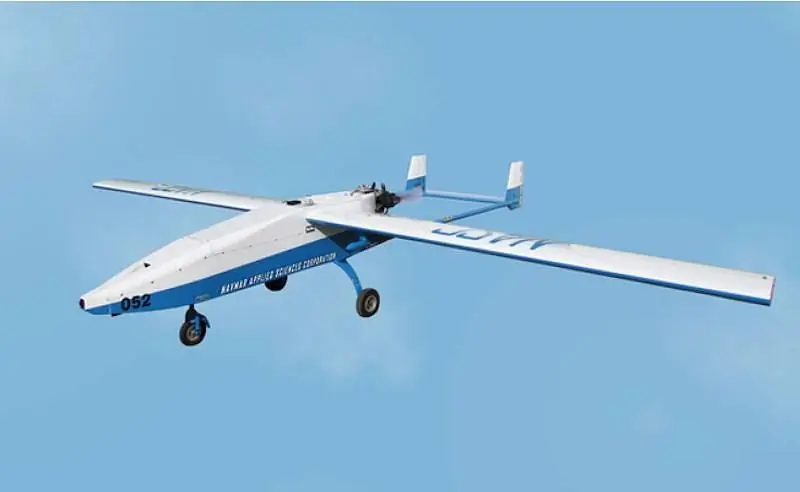
In the second phase, Lockheed took the lead in flight testing, while Raytheon validated the open software architecture and provided the actual testing. Flight tests were carried out in California, they were attended by RQ-23 TIGERSHARK UAVs with CODE equipment and software to control direction, altitude, speed and the sensors themselves.
Real and simulated TIGERSHARK UAVs used network relative navigation in the absence of a GPS signal, for example, used an onboard planning function to adapt to dynamically changing situations, automatically change trajectories in the event of sudden emerging threats, and reassign roles when one or more team members are lost.
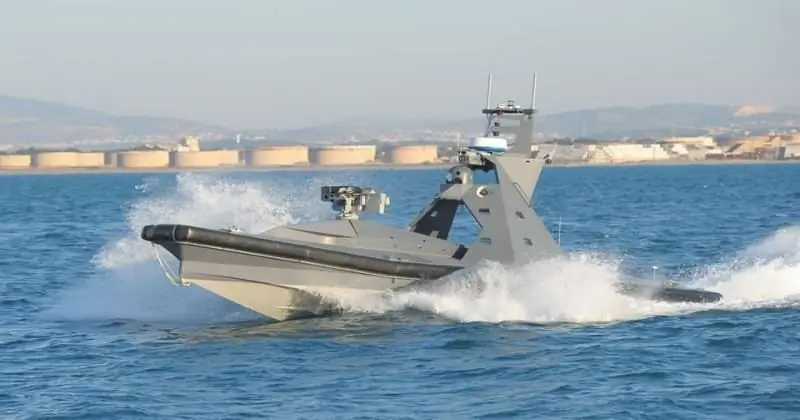
DARPA selected Raytheon to complete the CODE software development in Phase III. If everything works as intended, then we can expect that existing UAVs will become more tenacious, flexible and efficient, as well as reduce their cost and accelerate the development of future systems.
“Phase 2 flight testing exceeded his infrastructure goals and showed the direction for future collaborative autonomous capabilities that CODE will provide,” said the CODE program manager. "In Phase 3, we anticipate further expanding CODE's capabilities by testing more vehicles with greater autonomy in more challenging scenarios."
Combined with innovative craft designs designed to operate in all environments, the interaction between unmanned and manned systems teams is likely to unlock the true potential of this rapidly advancing technology.
Ground attack
The US Army is the largest operator of ground-based mobile robots (HMP) and yet is poised to adopt the next generation of systems.
For example, in October 2017, it awarded Endeavor Robotics a contract for the Man Transportable Robotic System Increment II (MTRS Inc II) program to be completed over two years.
The robot weighing about 75 kg, although new, will still be based on the systems already developed by the company. It will carry out operations to neutralize improvised explosive devices, detect chemical and biological weapons, and clear routes.
Endeavor Robotics also offers the Common Robotic System - Individual (CRS-I) military program, which will perform the same task as the MTRS Inc II robot, but weigh only 11.5 kg. Request for proposals for it was issued in 2017, and the contract was issued in 2018.
After the full compliance of the FirstLook robot with the requirements of the German military was determined and as a result of defeating "worthy rivals", the company received a contract from Germany for 44 such abandoned robots.
“I am really proud of the work that our group has done,” said the director of Endeavor. “FirstLook is an essential tool used by soldiers and first responders everywhere to keep them safe from deadly threats. We are delighted to bring these critical opportunities to our German allies.”
Another new system on the market is the 342 kg T7 remote control vehicle, which was first introduced by Harris in 2017. It was acquired by the British Army as part of the Starter program.
A versatile robot is offered for various structures, including the military, law enforcement; it features tactile navigation and a variety of touch kit options.
“T7, as a base system, is a multi-purpose flexible platform. The first British order for it was exactly as a robot for disposal of unexploded ordnance, but we also see interest from customers in this system as a system for WMD reconnaissance and work with hazardous materials, said a Harris spokesman. "At the same time, the platforms for the military should be stronger than for the police, for example."
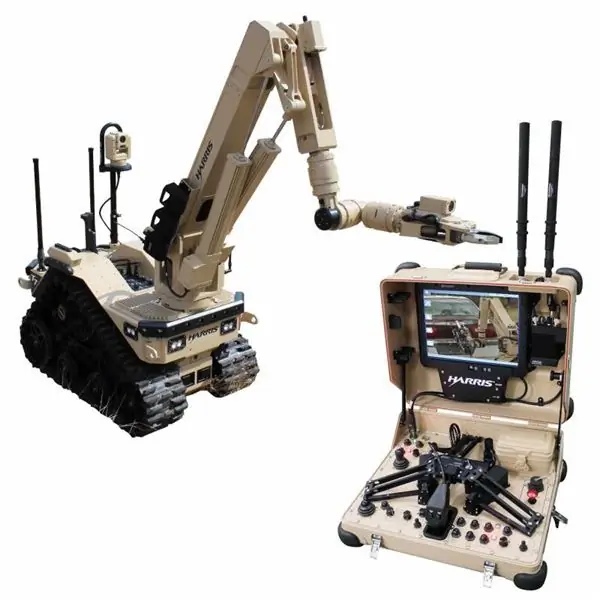
He noted that there is a need for uniformity in all types of operations, and one country wants to purchase a robot for the military and police from Harris so that it can have common accessories, training tools, and so on.
“Not everyone uses robots this way; some prefer small robots as they are just a set of eyes and ears. And if you just want to get your camcorder indoors, why do you need something bigger than what just fits in your backpack? he added. - Of course, this is not the same size robot that could suit all customers. With larger robots, you have additional options in terms of range and effort. This allows you to work in hazardous object disposal tasks, a large robot allows you to work with cars loaded with explosives, which you cannot do with a small or medium robot."
The Estonian company Milrem, in cooperation with Raytheon UK, Advanced Electronics Company and IGG Aselsan Integrated Systems, offers the TheMIS modular remote-controlled vehicle in three configurations: with a weapon module, a cargo version with a payload of up to 750 kg and an explosive ordnance disposal option. The THeMIS can also be used for the evacuation of the wounded, as a base station for a UAV, including for charging it, or as a sensor platform. As practice has shown, with one base platform for different applications, the cost of maintenance and training is reduced.
“What we are developing is a system of uninhabited systems. That is, a combat unit can be equipped with various platforms, this can increase its combat effectiveness and reduce the need for manpower. Of course, more importantly, the soldiers will not find themselves in dangerous situations,”said the director of Milrem.
“The success of Milrem's solutions in the Middle East and Asia, as well as in the United States, is real proof that research and development even in such a small country as Estonia is very possible and at the highest level,” he said.
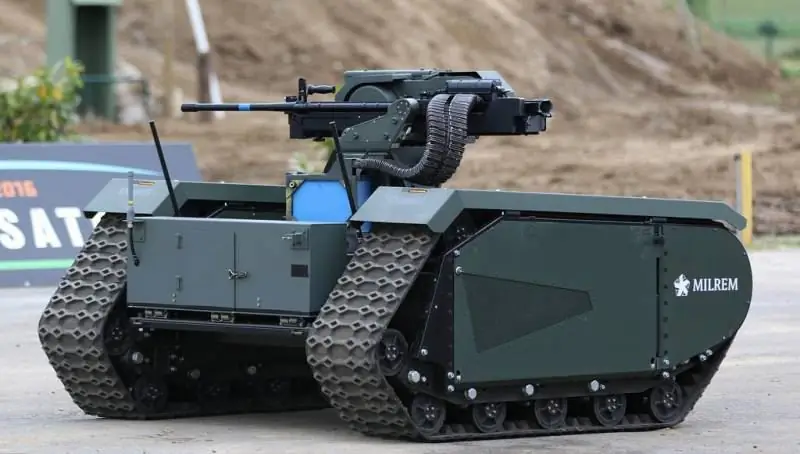
Rebel robots
In warring countries such as Iraq and Syria, non-state actors are also demonstrating their ability to build robots. In the past year, more than 20 different remote-controlled systems have been identified, appearing from time to time in various locations in the two countries.
The Sunni Shaba Media channel in Aleppo, for example, has posted videos of its remote-controlled 12.7mm DShK machine guns with 180 degrees of fire (known as the SHAM series) on the Internet, which are controlled by a controller similar to those used for commercial video games.
Former Iraqi police officer Abu Ali assembles various remote-controlled vehicles, both wheeled and tracked, for one of the units fighting IS militants (banned in Russia). At least two homemade robots are known: ARMORED TIGER and KARAR SNIPING BASE. Three rocket-propelled grenade launchers are mounted on the ARMORED TIGER platform. The KARAR SNIPING BASE robot has a strong enough hydraulic hook arm that can be used to drag the injured person to safety.
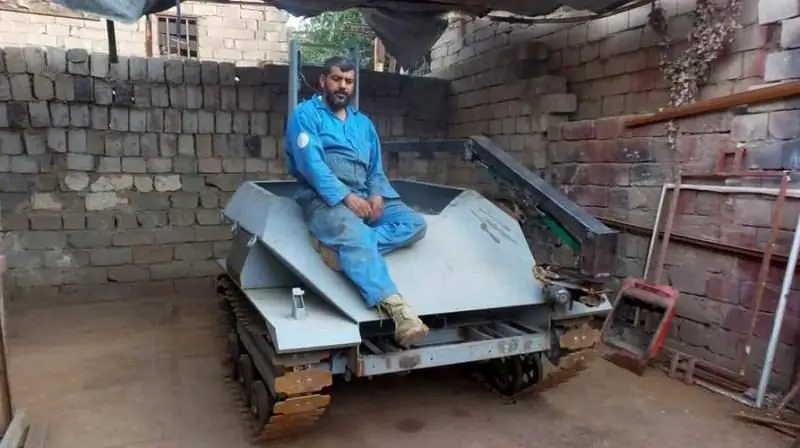
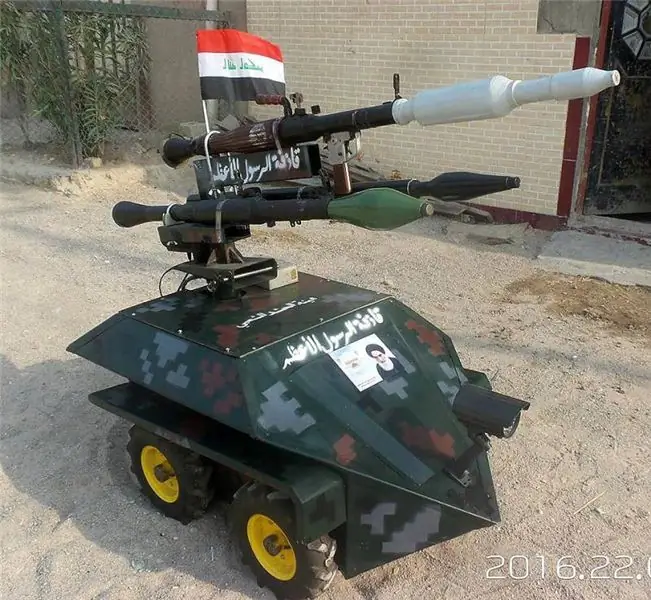
Joystick controls, cameras for viewing and aiming, Android operating systems, WiFi or Bluetooth technology are all advantages of Western technical solutions, but you have to pay from 1000 to 4000 dollars for this.
“If we had enough money, we could implement a lot of new ideas,” said a spokesman for Rahman Corps, a technical group based in the eastern suburbs of Damascus that manufactures a weapon system, which is a machine gun mounted on a rotating platform controlled by joystick and video monitor.
“At this technological level, I do not think that these systems will be able to act as a decisive means in battle. But I have no doubts that at certain moments they can influence this or that situation. One way or another, it is necessary to improve your technical level, this applies not only to our group, but also to our entire country."






